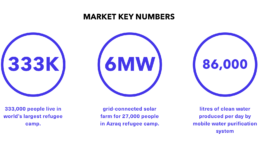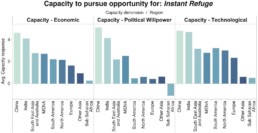As the number of forcibly displaced people rises, the need for adequate shelter increases. In rural settings, refugee camps are built to provide protection, ensure personal security, and deliver humanitarian assistance.
By supporting quick and efficient responses to housing, sanitation, equipment maintenance, and many other basic services, businesses can help fulfil the needs of millions of refugees around the world.
A refugee camp is a form of instant urbanisation, and the world’s largest camp is home to as many as 320,000 people. According to United Nations High Commissioner for Refugees (UNHCR), more than 2.6 million refugees currently live in camps around the world and have been displaced for more than five years, some even for over a generation. No matter the size, they have to be able to provide the same basic services as any other city.
Business can play an active role by supporting humanitarian agencies in delivering infrastructure and services to these quickly forming cities. It is an emerging opportunity space that benefits business, the humanitarian community, and refugees.
In this opportunity space, rapid scaling of effort to meet the needs of the displaced is pivotal. In addition, co-creation of products and services can play an important role. Products can be designed by refugees for refuges to meet their particular demands. The power to innovate is put into the hands of refugees themselves. The result can be innovations, which can be scaled and adapted to other parts of the world.

Products and Services
By their very nature, refugee camps entail huge logistical processes. They often need to be created and functioning within a short time to support thousands of refugees fleeing their homes. The products and services camp residents also require – housing, sanitation, food, water, healthcare, connectivity, and education – have be deployed immediately.
Advanced technologies like 3-D printing, are increasingly being used due to the speed with which solutions can then be replicated and adjusted to the local context. Another example of employing cutting-edge technology to improve living conditions in refugee camps is the use of drones for fast and reliable data collection and wearable technologies to alert people, encourage behavioural change, or diagnose health needs.
Market Size and Demand Drivers
On average, 24 individuals worldwide were newly displaced every minute during 2015. As conflicts continue to rage, the number and needs of displaced people show no sign of slowing down. By supporting humanitarian agencies, businesses have the opportunity to help provide improved living conditions through better products and services for these millions of people around the world. By building products which cater directly to people, businesses support the nearly 65 million displaced people worldwide and the 3 million residing in camps.
Survey Findings
Instant refuge received its highest ranking in the MENA region in our 2015 global survey. Leaders in Sub Saharan Africa were less positive about this market.

The main reason this opportunity receives a less positive rating in the survey is leaders do not think the capacity currently exists to enable this market. Overall, it has been assessed the lowest of the 15 markets surveyed in 2016, across all three dimensions of economic, technological, and political capacity. However, respondents in the MENA region seem more confident the economic and political capacity exists to enable the growth of this market, whereas they are more skeptical when it comes to the technological capacity to enable it.

Globally, all sectors generally believe there is a weaker business case compared to the other 15 opportunities surveyed 2016, in delivering products and services to displaced people.
The survey findings put the opportunity high on the agenda of civil society. Political stakeholders in the MENA region can be expected to be lead advocates for this opportunity relative to other regions.
This market was surveyed globally in 2016 by more than 5500 leaders from both the public and private sectors. The survey was conducted in collaboration with the research company YouGov. The survey results were originally published in the Global Opportunity Report 2017.

